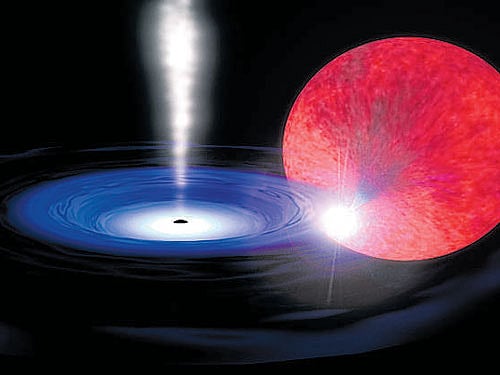
Astrosat, the Indian space telescope, has found a new, interesting feature about an enigmatic black hole that could help scientists unravel some of the mysteries about the cosmic monster.
Located at a distance of 40,000 light years (one light year is 9 trillion km) in the constellation of Aquila, the black hole is part of a two-star system, both of which are extremely hot, radiating several types of high-energy rays.
Using the Astrosat data, Indian astronomers identified some peculiarity in the high-energy or hard X-ray release pattern that could eventually lead to a better understanding of the black hole — the dying phase of a heavyweight star, which is too heavy even for light to escape, making them black.
Black holes are one of the most esoteric and widely studied astronomical objects.
The existing fleet of space telescopes could not see this oddity, picked up by the instruments on board the Astrosat, which was launched in September 2015.
“We made the discovery with only nine hours of Astrosat observation. The telescope will be in space for the next 5-10 years and can generate more valuable scientific information,” Ranjeev Misra, an astrophysicist at the Inter-University Centre for Astronomy and Astrophysics (IUCAA), Pune, who is part of the team that made the discovery told DH.
Besides the IUCAA scientists, researchers from the Tata Institute of Fundamental Research, Mumbai; University of Mumbai and Raman Research Institute, Bengaluru, are also part of the group.
The black hole is part of a binary star system known as GRS 1915+105 which consists of a regular star and a black hole.
The regular star has a temperature of about 6000 degrees Kelvin. The black hole strips matter from the star to form an accretion disc whose temperature is about 100 million Kelvin.
“The system was 50,000 times more luminous than our sun. Yet just like a flickering candle, the strength of the X-ray emission changes in one-fifth of a millisecond. This has never been seen before,” Misra said. The two-star system was discovered way back in 1992 and observed by many scientists through different telescopic windows so far.
“The discovery may help understand new aspects of Albert Einstein’s general theory of relativity and probe the space-time around the black hole,” he said. The findings are accepted for publication in Astrophysical Journal.
